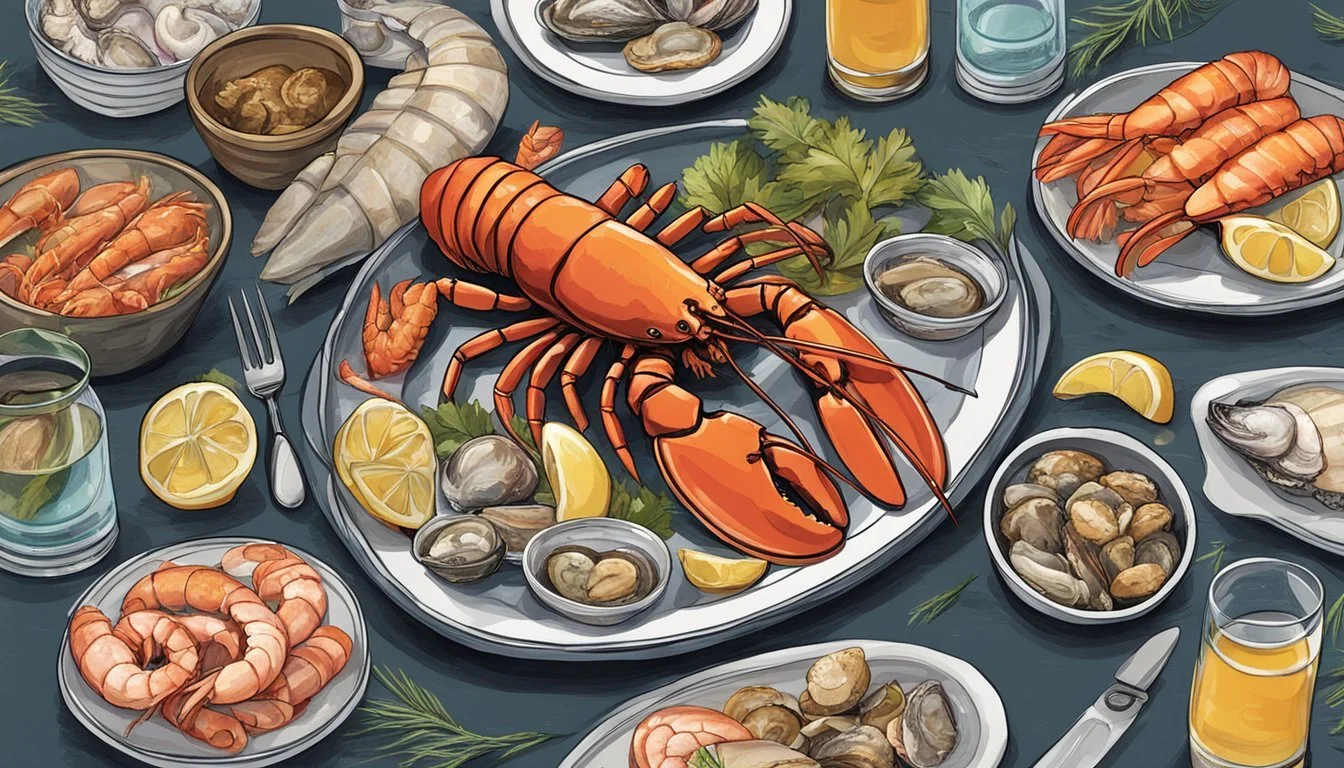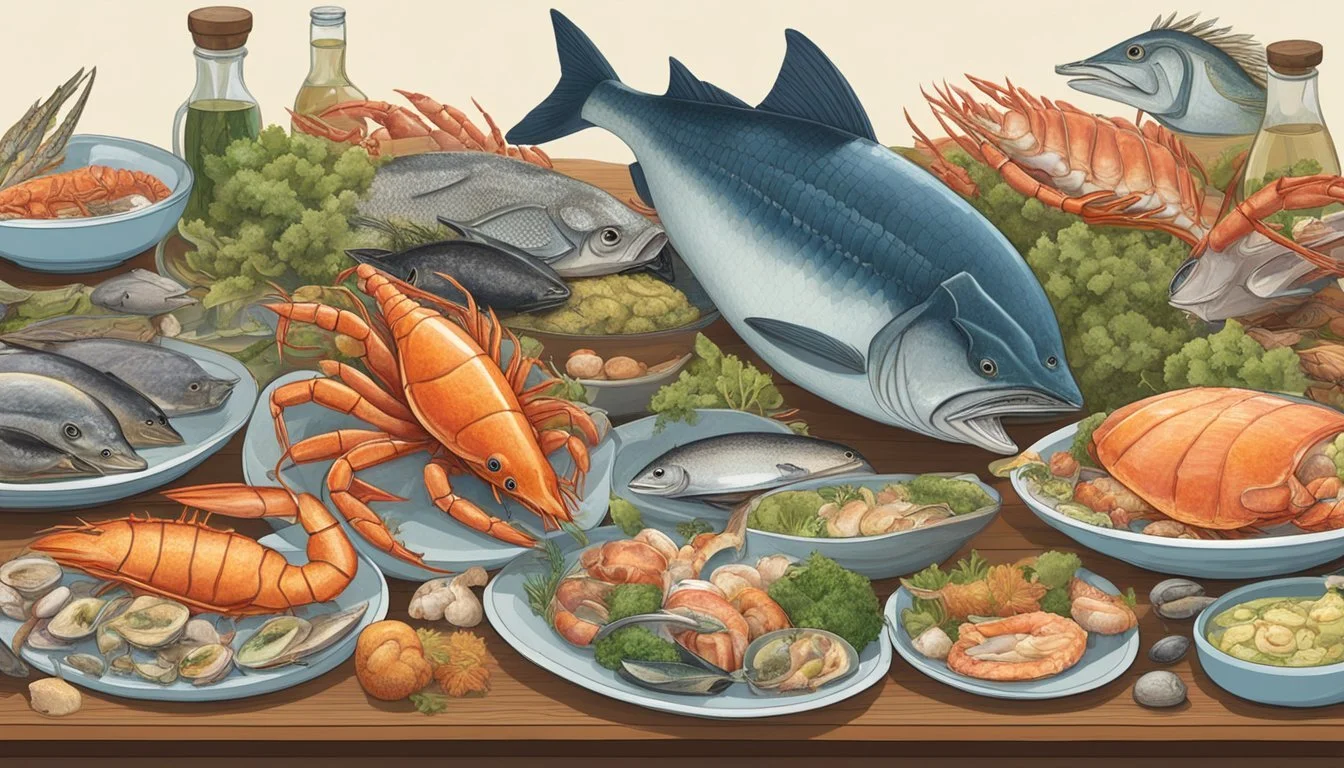How to Incorporate Seafood into Your Carnivore Diet
Boosting Variety and Nutrition
Incorporating seafood (What wine goes well with seafood?) into a carnivore diet can enhance its nutritional profile significantly. While the traditional carnivore diet primarily consists of meat from land animals, adding seafood offers a variety of nutrient-dense options, which are also rich in essential fatty acids and minerals. These aquatic offerings can provide benefits such as increased omega-3 fatty acids, vital for cognitive function and cardiovascular health.
Seafood is a broad term that encompasses fish and shellfish, (What wine goes well with shellfish?) providing a rich source of high-quality protein that complements the protein received from other animal products. Options such as salmon, (What wine goes well with salmon?) mackerel, sardines, and oysters (What wine goes well with oysters?) not only vary the diet's flavor profile but also contribute unique nutrients that might be less abundant in terrestrial meats. For instance, shellfish are known for their zinc and iodine content, while fatty fish are an excellent source of vitamin D.
Those adhering to a carnivore diet and seeking to maximize its potential should consider the strategic integration of seafood into their meal planning. It is not only about adding variety; seafood can be pivotal for long-term sustainability and optimization of the diet. Whether it's selecting the right types of fish or understanding the ideal preparation methods, the goal is to maintain the carnivore diet's focus on animal products, while ensuring the diet remains diverse and nutritionally complete.
Benefits of Including Seafood in Your Carnivore Diet
Incorporating seafood into a carnivore diet augments its nutritional spectrum by providing an array of essential nutrients, enhancing brain and heart function, and offering anti-inflammatory benefits.
Rich in Essential Nutrients
Seafood is an excellent source of high-quality protein and contains an abundance of vitamins and minerals. Fish, for instance, delivers essential nutrients that are crucial for maintaining overall health. These nutrients include vitamin D, B vitamins, selenium, and iodine.
Vitamin D: Essential for bone health and immune function.
B Vitamins: Aid in energy production and the creation of red blood cells.
Selenium: Has antioxidant properties that protect cells from damage.
Iodine: Necessary for proper thyroid function.
Supports Brain Health and Function
Seafood is rich in omega-3 fatty acids, particularly EPA and DHA, which are known to be beneficial for brain health. Regular consumption of seafood can contribute to improved cognitive function and may reduce the risk of certain mental conditions.
Omega-3 Fatty Acids:
EPA: May benefit mood and reduce symptoms of depression.
DHA: Integral for brain development and function, neuroprotective.
Promotes Heart Health and Reduces Inflammation
Incorporating seafood into one's diet can lead to better heart health. The omega-3 fatty acids found in seafood are known for their ability to reduce inflammation and may lower the risk of heart disease.
Omega-3s:
Help decrease triglycerides, reduce blood clotting, and decrease the risk of strokes.
Can lower blood pressure slightly and improve arterial health.
Selecting High-Quality Seafood
Selecting high-quality seafood is critical for anyone looking to supplement their carnivore diet with nutrient-rich options. Consumers should understand the labels and certifications associated with seafood quality and be familiar with the nutrient profiles of different seafood varieties.
Understanding Labels and Certifications
When purchasing seafood, it's important to look for certain labels and certifications that indicate quality and sustainability. The Marine Stewardship Council (MSC) is one well-known certification that signifies sustainable fishing practices. Seafood bearing the MSC blue label has been sourced from wild-catch fisheries that have been independently assessed on their sustainability. Additionally, labels like 'wild-caught', 'organic', or 'responsibly farmed' can also inform buyers about the sourcing standards.
Seafood Variety and Nutrient Profiles
Variety in seafood choices can lead to a more nutrient-rich diet. Including different types of fish and shellfish like salmon, tuna (What wine goes well with tuna?), mackerel, crab (What wine goes well with crab?), and oysters can provide a wide range of nutrients beneficial for health. Salmon is known for its high content of omega-3 fatty acids, while oysters are rich in zinc. A nutritionist may recommend a diversity of seafood to benefit from the various nutrients they offer.
Nutrient Content in Common Seafood:
Salmon: Rich in omega-3 fatty acids, vitamin B12, and protein.
Tuna: Good source of protein and selenium.
Mackerel: High in omega-3 fatty acids and vitamin B12.
Crab: Contains vitamin B12, zinc, and selenium.
Oysters: Excellent source of zinc, vitamin B12, and omega-3 fatty acids.
By focusing on the nuances of labels and embracing a variety of seafood, consumers can ensure they are selecting high-quality, sustainable, and nutrient-rich options for their carnivore diet.
Incorporating Different Types of Seafood
When adopting seafood into a carnivore diet, it's vital to account for both variety and nutritional content. This ensures a balance of protein intake and the absorption of various nutrients, achieved through a selection of fatty and lean fishes, as well as a diversity of shellfish.
Fatty Fish and Lean Options
Fatty Fish: They are a cornerstone for those seeking high-value nutrition, giving a rich source of omega-3 fatty acids and vitamin D.
Salmon: A popular choice, providing a robust flavor and versatility in preparation methods—grilled, baked, or steamed.
Mackerel: Less common but just as nutritious, mackerel can be an economical addition, offering a distinctive taste.
Sardines: Small yet packed with nutrients, sardines are convenient to incorporate in meals, often grilled or baked.
Lean Fish: An excellent alternative for lower fat options, still ensuring a high protein quota.
Cod: Its mild flavor and firm texture make it a favorite for baking and the perfect canvas for seasoning.
Tuna: When not consumed as sushi or sashimi, it can be grilled to maintain its moisture and flavor.
Shellfish and Other Marine Options
Shellfish offer both variety and a plethora of flavors and textures, complementing the carnivore diet's focus on animal-based foods.
Oysters: Known for their strong mineral content and typically served raw or steamed.
Shrimp: Highly versatile, able to be grilled, baked or steamed, fitting into various types of preparations.
Crab: A fine delicacy either on its own or as an addition to other dishes, often steamed to preserve its delicate texture.
Scallops: When seared or grilled, they offer a succulent addition to any meal.
Lobster (What wine goes well with lobster?): Best when steamed or grilled, lobster serves as a luxurious and protein-rich inclusion to the diet.
Handling and Preparation Techniques
The way seafood is handled and prepared can significantly affect both its taste and nutritive value.
Grill: Ideal for fatty fishes like salmon and tuna, grilling enhances their natural flavors while imparting a smoky note.
Bake: A method that suits nearly all seafood, preserving moisture and tenderness, especially for lean fish like cod.
Steam: This method is best for shellfish such as oysters and crab, ensuring a gentle cooking process that retains nutrients and flavor.
Using these cooking techniques in combination with the chosen seafood will allow one to enjoy a well-rounded carnivore diet that includes all the health benefits that these marine foods have to offer.
Optimizing Your Meal Plan
To successfully incorporate seafood into a carnivore diet, one must focus on balance, practical eating tips, and portion control. These specific strategies aid in maintaining nutritional adequacy while enjoying the benefits of varied protein sources.
Balancing Seafood with Other Animal Products
Including seafood in the carnivore diet introduces essential nutrients not as prevalent in land-based animal products. Salmon and mackerel, for instance, are rich in omega-3 fatty acids, vital for heart health. A balanced meal plan alternates between beef, pork, chicken, and organ meats, ensuring a diverse intake of proteins and nutrients. An individual might structure their week as follows:
Monday: Ribeye steak (What wine goes well with ribeye steak?) (rich in protein and healthy fats)
Tuesday: Grilled salmon (What wine goes well with grilled salmon?)(providing omega-3s and vitamin D)
Wednesday: Pork chops (What wine goes well with pork chops?) (a good source of thiamine)
Thursday: Chicken liver pâté (high in vitamin A and B12)
Friday: Shrimp and scallops (What wine goes well with scallops?) (low in fat, high in iodine and protein)
Practical Tips for Daily Eating
Integrating seafood into daily meals requires thoughtful planning. Individuals can opt for canned fish like tuna or sardines for convenience and affordability. Eggs and dairy (if tolerated) also offer valuable nutrition and can be paired with seafood for a satiating meal. A daily meal outline could include:
Breakfast: Scrambled eggs with cheese and smoked salmon
Lunch: Tuna salad made with full-fat mayonnaise
Dinner: Grilled mackerel with a side of butter-fried shrimp
Snacks: Oysters or a chunk of hard cheese (for those who include dairy)
Adjusting Portions and Frequency
Portions and meal frequency depend on individual dietary goals, activity levels, and nutritional needs. Those requiring higher protein intake might prioritize larger portions of lean seafood like cod or halibut, with occasional servings of fattier fish. Conversely, individuals needing more healthy fats might lean towards fish like salmon or herring, while moderating portion sizes of leaner meats. Monitoring one's response to the diet and adjusting as needed is crucial.
Seasonings and Additives
When incorporating seafood into a carnivore diet, the judicious use of seasonings and herbs can enhance the flavor of the dish while keeping it aligned with the diet's emphasis on animal-based foods.
Choosing Compatible Spices and Herbs
For those following a carnivore diet, the selection of spices and herbs should focus on those that complement the natural flavors of seafood without adding carbohydrates or grains. Salt and black pepper are fundamental seasonings that are not only permissible but also enhance the inherent taste of seafood. Here is a concise list of compatible seasonings:
Salt: A basic yet essential mineral that brings out the seafood’s flavor.
Black Pepper: Adds a subtle heat that accentuates the natural savoriness.
In addition to these basics, some people may choose to include:
Garlic Powder: Offers a robust flavor while remaining low in carbohydrates.
Onion Powder: Provides a hint of sweetness and depth to seafood dishes. (What wine goes well with seafood dishes?)
Herbs like rosemary and thyme: These can impart a refreshing and savory note to the flesh of fish and shellfish.
Enjoy the convenience of doorstep delivery when you buy salt, black pepper, garlic powder, and onion powder online!
Avoiding Non-Carnivore Ingredients
Ingredients that fall outside the carnivore diet's guidelines are best avoided to maintain the diet's integrity. This means excluding seasoning blends that contain grains, added sugars, or excessive carbohydrates. Additionally, ready-made sauces and commercial condiments typically have a range of non-carnivore ingredients such as:
Barbeque sauce
Ketchup
Tomato sauce
Commercial salad dressings (like ranch)
These products often include preservatives and added ingredients that deviate from the carnivore philosophy. Instead, individuals should seek out natural flavors that complement the nutrition provided by seafood without incorporating unwanted plant-based elements.
Common Questions and Misconceptions
When incorporating seafood into a carnivore diet, individuals often have questions regarding safety, nutritional benefits, and comparisons with other animal proteins.
Addressing Concerns about Mercury and Toxins
Seafood is a nutritious part of a carnivore diet, but many are concerned about mercury and toxins. To mitigate these concerns:
Opt for lower-mercury fish: Choose fish like salmon, sardines, and trout over higher-mercury species like swordfish and shark.
Consult with a nutritionist: For personalized advice, especially if pregnant or nursing, working with a nutritionist can provide tailored guidance.
Understanding the Role of Seafood in Muscle Maintenance
Seafood is an excellent source of high-quality protein that is essential for muscle repair and maintenance on a carnivore diet.
Amino acid profile: Seafoods such as fish are complete proteins, containing all essential amino acids the body requires.
Protein comparison: Gram for gram, the protein in seafood can rival that of chicken, beef, and game meats like venison (What wine goes well with venison?).
Comparing Seafood to Land Animal Proteins
Seafood provides unique benefits compared to land-based meats such as steak, pork, and chicken.
Omega-3 fatty acids: Fish contain omega-3 fatty acids, which are important for cardiovascular health and are not as prevalent in land animal fats.
Nutrient density: Seafood often contains a variety of nutrients like iodine and selenium, making it a valuable part of a carnivore diet.








